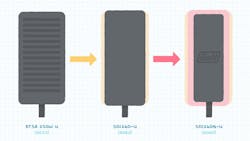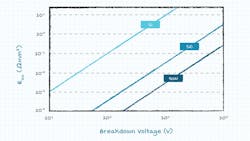It’s Time to Get GaN in Your Power Adapters
What you'll learn:
- The ever-shrinking power supply.
- How GaN helps further the miniaturization of PSUs.
- Why manufacturers need to get into the GaN game now.
We all know that each new generation of our gadgets and home electronics gets smaller and faster, with better features. It’s something that just happens and probably few consumers ever give a thought to how. Some may be aware of the famous Moore’s Law. It’s about the chips, right? But what about the power supply that brings life to all of these products? Can that really be the subject of exciting innovation?
In fact, there’s an exciting evolution happening in power conversion right now and it’s sure to leave some companies behind.
We all have more electronic gear, plugged into the wall, in our homes now than in previous generations. If these electronic devices don’t have an internal power supply, then there’s an external power adapter. It’s often simply easier for product designers to choose an external adapter off-the-shelf to be shipped in the box, rather than integrate a power supply or design power circuitry to go inside the enclosure.
If every one of those adapters could be smaller, say about one-third the size of the previous generation, that change could improve living space in people’s homes, as well as in offices and other spaces using large amounts of electrical equipment. Think about that row of treadmills in the gym, and how much the owner would like to tidy up and make better use of the area around them.
Rethinking Power-Supply Design
Some significant steps have been taken in power-supply design to help reduce the amount of space needed for power conversion. Old-fashioned linear power supplies built with passive components have given way to switched-mode power conversion over the last two to three decades, delivering significantly smaller and more efficient power supplies.
Subsequently, refining the circuit designs and optimizing silicon power transistors for switched-mode operation has allowed typical power-supply dimensions to become smaller and smaller by raising the switching frequency. This, in turn, enables smaller components to be used, such as inductors, capacitors, and heat sinks.
Consumers will almost certainly only notice in passing that the adapter for their latest laptop is about half the size of the last one they had (Fig. 1). It’s achieved through higher switching frequencies and small changes to the topology of the conversion circuitry.
Now we’re on the cusp of another great move forward in power-supply design, and it could bypass those organizations that tend to be over-cautious or reserved.
The Rise of GaN
The technology in question is gallium nitride (GaN), and early adopters are launching the first generations of GaN-based power supplies in markets right now. This is where established brands need to pay close attention. Failure to keep pace in the market risks that competitors or new companies entering the market will become the new technology leaders—making the incumbents the market leaders in waiting. And that transition can happen quickly.
GaN is a wide-bandgap semiconductor technology with properties that allow for higher switching frequency and lower conduction and switching losses compared to silicon transistors. The higher switching frequency enables miniaturization, which means using smaller transformers and inductors, and the lower losses result in less heat dissipation permitting a smaller heat sink.
The on-state resistance also is smaller relative to important parameters such as the voltage and current rating (Fig. 2). This further reduces wasted power when operating.
Designers need to apply the engineering practices learned for high-frequency design to control the transistors and extract the best qualities from the new technology. Early adopters are gaining a head start on this learning curve as they deliver their first GaN-based power supplies to the market, and then begin to expand their portfolios
It’s the start of a new era in power technology that’s expected to yield many more improvements as we continue exploring GaN’s potential to enable new products that look better, are more economical, and ready to meet increasingly stringent eco-design regulations.


